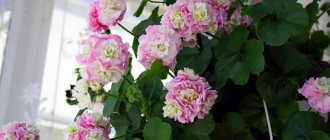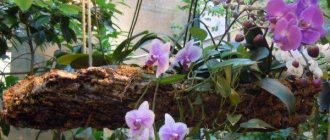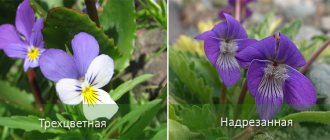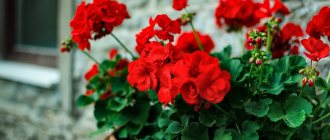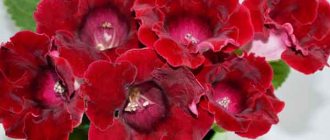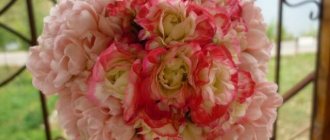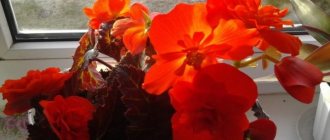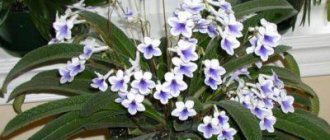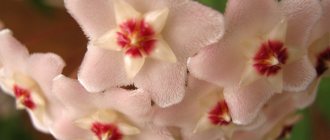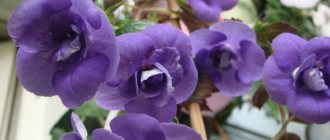Description
Pelargonium Anita belongs to rosebud varieties , which means it can boast of wonderful decorative buds that resemble roses in shape. The variety is enjoying increasing attention and love from flower growers due to its high decorative qualities and relative ease of cultivation.
REFERENCE! Pelargonium Anita is a product of artificial selection. In general, rosebud pelargoniums were born thanks to an artificial mutation. The specific characteristics have taken root, and now rosebuds are a separate, widespread variety of pelargonium.
Anita is distinguished by good growth and does not require too much attention and care. The shape of the bush is compact and does not require too careful and frequent pruning.
Appearance Features
Pelargonium Antita can boast of the highest decorative qualities . The flowers of the plant are large, very similar to roses, having a pale pink color and a large number of delicate petals. The flowers have a regular round shape, their core is closed, and the formed caps are dense and quite large. The peculiarity of the variety is its beautiful glossy light green leaves, against which the delicate beauty of the flowers is even more noticeable.
The variety blooms wonderfully: the plant is able to form quite a lot of inflorescences during the season, which gives the bush a lush, elegant appearance.
The height of this pelargonium bush reaches half a meter. Note that thanks to phytoncides, the plant has a beneficial effect on the microclimate of the room , killing pathogens in the air.
Photo
Meet this beautiful flower in the photo:
Landing
Let's find out what requirements Anita places on her habitat: we'll find out where to place the pot with this plant, what conditions it needs for successful growth and flowering.
Location and lighting
IMPORTANT! Rosebud pelargonium is afraid of direct sunlight, which can leave burns on its delicate petals and lead to the plant losing its decorative qualities.
Therefore, place the plant on windowsills, protected from bright sun . Note, however, that when growing a plant outdoors, sunlight ceases to be dangerous: and in this case, Anita does not require shading.
Temperature
The plant does well in moderate ambient temperatures. Note that too low a temperature is not suitable for Anita, so do not allow the plant to remain for a long time at temperatures below +10 degrees. Otherwise, flower diseases are likely, including incurable blackleg, loss of decorative qualities, poorer health and lack of flowering.
Note that in the summer you can take the plant out into the open air . Rosebud pelargoniums feel good in the air, and Anita is no exception. We note, however, that if the temperature drops significantly, the plant should definitely be brought back into the house, since Anita has difficulty withstanding long periods of cold weather.
Soil Features
For Anita pelargonium, it is important to choose the correct soil composition. The soil in which the plant is located must be nutritious and breathable. The following soil mixture is best suited for this variety :
turf soil - 4 parts;- peat soil - 2 parts;
- coarse sand - 1 part;
- fine perlite - 1 part;
- humus - 2 parts.
If you don’t want to mix the soil yourself, use ready-made soil mixtures, which are widely available on the market. Choose those mixtures that say “for geraniums” or “for pelargoniums.”
Please note that the acidity of the soil in this case should be neutral or very slightly acidic. Significantly acidified soil of rosebud pelargonium is not suitable .
Pelargonium Anita: what you need to know about the variety
Pelargonium Anita belongs to the rosebud zonal pelargoniums. The variety can boast of being highly decorative, which, combined with its ease of care, has become the reason for the plant’s high popularity among flower growers.
Since all the advantages of Anita are revealed with proper maintenance, it is important to choose suitable conditions for the bush and provide minimal attention
Anita: description and main features of the variety
Pelargonium Anita
Pelargonium Anita is obtained from the famous variety Swanland Pink/Australien Pink Rosebud, bred by the Swedish nursery Sutarve. The plant is distinguished not only by the cool, soft pink color of the petals, but also by the shape of the flowers, which always keep the center closed. In addition, Anita can boast of the presence of characteristic greenish rays that radiate from the center of the bud, and glossy dark green leaves like tulip-shaped pelargoniums.
The flowers form dense and beautiful caps, which often take a long time to bloom, sometimes for a month. The inflorescences remain fresh for a long time and look very impressive against the backdrop of rich foliage.
One of the advantages of Anita pelargonium is high-quality flowering
During the season, the plant forms many caps, due to which it looks elegant and attracts attention on the windowsill. The buds bloom round, of regular shape, the inflorescences are often dense and quite large. To obtain a harmonious and compact crown, Anita, like other zonal pelargoniums, is pinched during growth.
To obtain a harmonious and compact crown, Anita, like other zonal pelargoniums, is pinched during growth.
It is important to start forming a bush from a cutting - this promotes the appearance of lateral buds. As a result, Anita will begin to actively branch, rather than grow into one trunk. The variety grows a bush up to half a meter high and does not take up much space, unlike standard pelargoniums.
This is an ideal plant for indoor growing, since it can be kept even in a small apartment
The variety grows a bush up to half a meter high and does not take up much space, unlike standard pelargoniums. This is an ideal plant for indoor growing, since it can be kept even in a small apartment.
During the formation of flower buds and budding, Anita requires regular feeding. Nutrients and microelements increase the decorative effect and duration of flowering.
Rules for growing pelargonium Anita
Anita needs conditions typical for zonal pelargoniums, that is, good lighting and warm content, a nutritious, but at the same time loose, permeable substrate.
Thus, growing Anita pelargonium comes down to several points:
- Lighting. It is preferable to have well-lit window sills that are exposed to the sun for several hours a day. On the south side, it is advisable to shade the pots so that the leaves do not suffer from burns; it is better not to grow them on northern windows;
- Watering. It is necessary to moisten the soil constantly, as the top layer of the substrate dries, but always in moderation. The earthen lump should neither dry out nor become waterlogged;
- Trimming. To obtain a compact bush with a harmonious crown, pelargonium must be pruned. Strong shortening of shoots is carried out at the end of February, sanitary pruning is carried out as necessary. Pinching the apical and lateral cuttings is also required;
- Feeding. During the period of bud formation and flowering, Anita must be fed using fertilizers for Geraniums or compositions for flowering indoor plants.
Like other zonal pelargoniums, Anita loves fresh air and ventilation, but reacts negatively to drafts. For this reason, with the onset of warm weather, the bush is taken out to the balcony, veranda or loggia, creating flower arrangements and always returning it to the apartment before the cold weather.
The optimal temperature for growing and flowering Anita is between +17-+23 degrees. When the temperature drops below +12, the plant stops developing and often dies from hypothermia of the root system.
The Anita variety will decorate your windowsill, delighting you with lush flowering if grown correctly.
Care
Let's get acquainted with the main points for caring for pelargonium Anita.
Watering
As for soil moisture, Anita loves moderate watering. The soil should not be dry, however, and the flower will not tolerate swamps either. If the leaves of a flower can wither due to the soil drying out, then waterlogging is dangerous because the root system can rot.
ATTENTION! It is recommended to water when the top layer of soil is noticeably dry. To make sure of this, touch the soil with your finger: if there is a dry crust, water the flower under the root with soft, settled water.
Trimming
In order for the pelargonium bush to take on a compact and regular shape, it must be periodically adjusted - pruned. Usually Anita is pruned after flowering , since it is dangerous to perform the procedure in the spring: there is a possibility of cutting off the formed inflorescences.
Young shoots that grow quickly must be pinched. The procedure is performed when 3-4 leaves appear on the shoot. Pinching will help stop the growth of the shoot and will promote its lateral branching.
Top dressing
In order for Anita to please the eye with its lush flowering for a long time, the plant must be periodically fed. It is best (and easier) to use ready-made mineral complexes intended for pelargoniums and geraniums. Please note that during the flowering period, Anita needs potassium and phosphorus so that it blooms more luxuriantly and for a longer period of time.
In winter there is no need to feed pelargonium. During this period, the plant hibernates, recovers and prepares for the new growing season: it is better not to disturb it at this time.
Growing rules
Geranium is very popular among gardeners not only because of its beautiful flowering, but also because of its easy care. Moreover, unpretentiousness is characteristic of all representatives of this genus. However, different varieties have some features in home care, which you must know about in order to achieve long-term flowering from the plant.
The optimal quantity for one hanging flowerpot with a diameter of about 20 cm is 5–7 pieces. It is worth noting that it is when planted in groups that plants bloom best. They seem to compete with each other, competing in the abundance of flowers.
Pelargoniums also look great on floor planters located on a high stem. The flowering period for representatives of this variety lasts from early spring to late autumn. But for such a long flowering period, home care should be as follows:
- timely watering. The soil in the pot should not be dry. But you shouldn’t flood the plant either. Excess moisture has an extremely negative effect on the root system, causing it to rot. At the same time, the geranium begins to thin out and wither. Also, high humidity creates optimal conditions for the development of pathogenic microflora and the appearance of parasites;
- plants should be placed on well-lit windowsills;
- periodic feeding. During the flowering period, Angels need a constant supply of nutrients. Therefore, from spring until autumn, you need to add special fertilizers intended for this variety of indoor plants into the pot. Fertilizers are applied to the pot once every two weeks;
- As the flowers grow, they are transferred to containers of larger diameter. However, due to their small size, their transplantation is carried out infrequently;
- Temperature is important for abundant flowering. The formation of buds is especially affected by the difference in night and day temperatures.
Caring for these flowers is also simple because they do not need to be pinched. Angel geraniums are excellent bushers on their own. Shoots emerge from the axils. However, this requires timely watering and good lighting.
Red Pelargonium of Angels
Burgundy Pelargonium Angels
White pelargonium of Angels
Pink Pelargonium Angels
If the plants are healthy and actively growing, propagation can be carried out by cuttings. But you need to be able to propagate indoor flowers by cuttings. Branches for propagation should be prepared carefully, choosing those shoots that contain several axils. It is worth noting that Angels, according to popular beliefs, attract wealth to the house. Therefore, you need to take good care of these flowers because they can affect your financial well-being.
Pests and diseases
Like any other indoor flower, rosebud pelargonium can also be threatened by diseases and dangerous harmful insects that can completely destroy the flower.
Next, we will get acquainted with the most dangerous diseases and pests for this variety.
Diseases:
The greatest danger for this plant is root rot. The disease occurs due to improper care and maintenance: if the room temperature is too low and with excessive watering, the roots of the flower begin to rot.
REFERENCE! This disease cannot be treated, and the only measure to save the flower from rot is limiting watering and observing the temperature regime.
Pests:
Of the insects, the most dangerous for Anita are the spider mite and the whitefly. Aphids can also damage the plant. To cope with insects, it is necessary to use insecticides, and also, for preventive purposes, regularly inspect the leaves to detect pest larvae.
Varieties
Scientists and breeders have bred hundreds of species of pelargonium with very different shapes of flowers and leaves. For example, the following:
Each species has characteristics unique to it. Of all the variety, the most hardy and unpretentious are zonal pelargoniums. Even with the most minimal care, they will delight you with the beauty of flowering. The plants are suitable both for growing at home and as a garden annual (with subsequent digging and wintering on the windowsill).
Pelargoniums are drought-resistant and tolerate lack of moisture well. On the contrary, they can die from excessive watering. They don't like intense heat. The optimal temperature for growth, development and flowering is from +20 to +25°.
Flowers grow well in the room; in the summer you can put pots with plants on the balcony or place them in the garden, on flower beds and in hanging flowerpots as a decorative element for decorating a gazebo or recreation area. By pinching and pruning, the plants are formed into a ball or small tree with a trunk. Zonal pelargoniums can also be divided into the following categories:
- by bush size: tall (more than 42 cm), medium (less than 40 centimeters), and short (below 12 cm);
- according to flower shape: simple, semi-double, double;
- by type of inflorescences: umbrella-shaped, spherical (the most common), phlox-shaped, rose-shaped, carnation-shaped, cactus-shaped, resembling dahlias and other flowers;
- by leaf color: simple green-leaved and variegated, which are grown exclusively for the beauty of multi-colored leaves of unusual shape.
How to reproduce?
This variety of pelargonium, being picky in care and maintenance, shows a little of its “character” when propagated. However, following planting and germination technology will help you grow a healthy and strong plant.
- Note that rosebud pelargoniums reproduce at home exclusively by cuttings , since during seed propagation these hybrids do not inherit maternal qualities. That is, from seeds you will get ordinary pelargonium, but not rosebud.
- In this case, cuttings can be carried out year-round . But experienced flower growers advise propagating Anita from March to July. Below is a detailed algorithm for the propagation procedure of this plant.
The first step is to separate a suitable apical cutting from five to seven centimeters long from the mother plant. It is important that the cuttings are semi-lignified, as soft green young shoots will not take root. It is necessary to cut off the process with a sharp knife with a sterile blade.- Use purchased soil for planting , since self-prepared soil will require thorough disinfection. And this procedure at home is quite difficult to carry out correctly.
- The cut cuttings are dried and planted in a plastic cup , where you must first make holes for drainage, filled with an earthen mixture. Before planting, it is important to cut off all the leaves from the bottom of the petiole (which will be underground) so that they do not rot underground.
- Within two to three weeks the cutting will take root . Water it carefully immediately after planting, avoiding flooding, but also not overdrying. You should water strictly at the root, or better yet, pour water along the edge of the glass. Use water sparingly so that the cuttings do not begin to rot before rooting.
- For successful rooting, it is important that the cuttings are well lit. If this happens during short daylight hours, provide the plant with additional artificial lighting.
IMPORTANT! The cutting should not be covered with anything, as this measure can lead to rotting of the shoot.
Pelargonium is famous for its diverse varieties. Read about Pak Salmon Comtesse, Stellar, Denise, Norland, Clara Sun, Rococo, Red Pandora, Grandiflora, Lady Gertrude, Patricia Andrea.
Propagation of geraniums by cuttings
Pelargonium Sutarve Clara San - variety characteristics and cultivation
Pelargonium Anita is propagated only by cuttings; the seed method is excluded, since the variety is a hybrid. This means that during seed propagation, the properties of the mother plant will not be transferred to the daughter plant. Cuttings can be taken at any time of the year when the plant is not dormant. The procedure is carried out as follows:
- A healthy, undamaged stalk about 5-7 cm long is cut from the plant, and the lower leaves are removed from it.
- The pot and soil are prepared. The substrate for propagation is no different from the one in which adult plants grow.
- Drainage holes are made in the pot and a small layer of expanded clay is laid out.
- The cuttings are planted in the soil, watered and placed in a place with lighting suitable for geraniums.
Within 2-3 weeks, rooting will occur and the young flower will begin to actively develop.
Pelargonium cuttings
